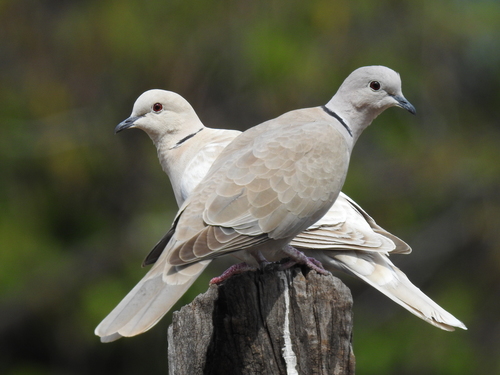
Eurasian Collared-dove
The Eurasian Collared-Dove (Streptopelia decaocto) is a member of the dove and pigeon family, known for its distinctive black collar marking on the nape of its neck. Originally native to warmer temperate regions of Eurasia, this species has demonstrated a remarkable capacity for range expansion, particularly across Europe and North America, during the 20th and 21st centuries. This expansion is often attributed to its adaptability to human-modified landscapes, including agricultural areas and urban environments. Ecologically, it plays a role in seed dispersal and serves as prey for various raptors. While not typically considered a bird of significant cultural importance, its rapid spread has made it a familiar sight to many.
30-33 cm
Length
47-55 cm
Wingspan
Least Concern
Conservation Status
Distribution
Native to Asia, from Turkey east to southern China and south through India to Sri Lanka. It has expanded dramatically, now found throughout Europe, North America (introduced in the Bahamas in the 1970s and spread to the US), and parts of North Africa. It is generally non-migratory, though some populations may make short-distance movements in response to food availability.
Lifespan
Typical lifespan in the wild is 3-5 years, but can be longer in captivity.
Eurasian Collared-dove's Habitat
Habitat Types
Urban areas, Suburban areas, Agricultural lands, Open woodlands, Villages
Climate Zones
Temperate, Subtropical, Arid
Adaptations
Highly adaptable to human-altered environments; thrives in close proximity to human settlements. Tolerant of a wide range of temperatures and habitat conditions, provided there is a reliable food source (primarily seeds) and suitable nesting sites.
Variations
Several subspecies have been described, but differences are often subtle, relating to slight variations in plumage color and size. The most widespread is *S. d. decaocto*.
Appearance
Breeding Plumage
Plumage is generally consistent year-round.
Seasonal Feather Changes
No significant seasonal variations.
Sex Based Plumage Differences
Males and females are visually very similar.
Notable Features
Black half-collar on the nape, edged with white., Pale grayish-buff overall plumage., Reddish eyes., Dark gray/black primary feathers.
Diet and Feeding
Primary Foods
Seeds, Grains, Cereals, Small fruits, Occasionally insects
Foraging Behavior
Forages primarily on the ground, often in open areas. Will also visit bird feeders. Typically feeds in small flocks, especially outside of the breeding season.
Specializations
No highly specialized feeding adaptations. Its generalist diet contributes to its ability to thrive in diverse environments.
Seasonal Diet Variations
Diet may shift slightly depending on local availability. For example, they might consume more spilled grain after harvests.
Behavior
Social Structure
Forms pairs during the breeding season. Outside of breeding, they often gather in small to medium-sized flocks, sometimes larger at abundant food sources.
Communication
Distinctive 'coo-COO-coo' call., Bowing displays during courtship., Wing-clapping during display flights.
Migration
Largely non-migratory, but some populations may undertake short-distance movements in response to severe weather or food shortages.
Territorial or Group Behaviors
Territorial during breeding, defending the immediate area around the nest. Otherwise, relatively tolerant of other individuals.
Conservation
Threats
Habitat loss (in some areas), Pesticide exposure, Predation by domestic cats, Collision with vehicles and windows
Protection Programs
Not currently subject to specific large-scale conservation programs due to its widespread and abundant status.
Local National Laws
May be protected under general bird protection laws in some countries, but often not specifically targeted.
Population Trend
Stable or Increasing
Population Estimates
Global population estimated to be in the tens of millions.
Interesting Facts
Rapid range expansion
One of the most successful avian colonists, expanding its range dramatically in the 20th century.
Name origin
The scientific name 'decaocto' is derived from a Greek myth about a servant girl who was turned into a dove.
Multiple broods
Can raise multiple broods per year, contributing to their rapid population growth.
Faqs about Eurasian Collared-dove
Are Eurasian Collared-Doves invasive?
While they are not native to many regions they now inhabit, the term "invasive" is complex. Their impact on native species is generally considered to be low, though more research is needed. They are often described as a non-native, introduced species.
What do Eurasian Collared-Doves eat?
They primarily eat seeds and grains, often foraging on the ground or at bird feeders.
How can I tell a Eurasian Collared-Dove from a Mourning Dove?
Eurasian Collared-Doves have a distinctive black collar on the back of their neck, which Mourning Doves lack. Mourning Doves also have pointed tails, while Eurasian Collared-Doves have squared-off tails.
Do Eurasian Collared-Doves mate for life?
They are generally monogamous during a breeding season and may remain paired for multiple seasons, but long-term pair bonds are not definitively proven.
Copyright @ Nature Style Limited. All Rights Reserved.
 English
English